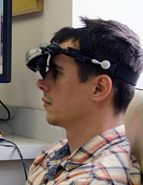 Amblyopia is the most common cause of visual impairment in childhood, affecting up to 3 per cent of the population.
Amblyopia is the most common cause of visual impairment in childhood, affecting up to 3 per cent of the population.
A research team led by Dr. Robert Hess from McGill University and the Research Institute of the McGill University Health Centre (RI-MUHC) has used the popular puzzle video game Tetris in an innovative approach to treat adult amblyopia, commonly known as “lazy eye”. By distributing information between the two eyes in a complementary fashion, the video game trains both eyes to work together, which is counter to previous treatments for the disorder (e.g. patching).
This medical breakthrough provides direct evidence that alleviating suppression of the weaker eye, by forcing both eyes to cooperate, increases the level of plasticity in the brain and allows the amblyopic brain to relearn. The research is published in the prestigious journal Current Biology.
Amblyopia is the most common cause of visual impairment in childhood, affecting up to 3 per cent of the population. It is caused by poor processing in the brain, which results in suppression of the weaker eye by the stronger eye. Previous treatments for the disorder, which have focused largely on covering the stronger eye in order to force the weaker eye to work, have proven only partially successful in children and have been ineffective in adults.
“The key to improving vision for adults, who currently have no other treatment options, was to set up conditions that would enable the two eyes to cooperate for the first time in a given task,” says Dr. Robert Hess, senior author of the paper and Director of Research Department of Ophthalmology at the RI-MUHC and at McGill University.
Read the full story here.
April 23, 2013
